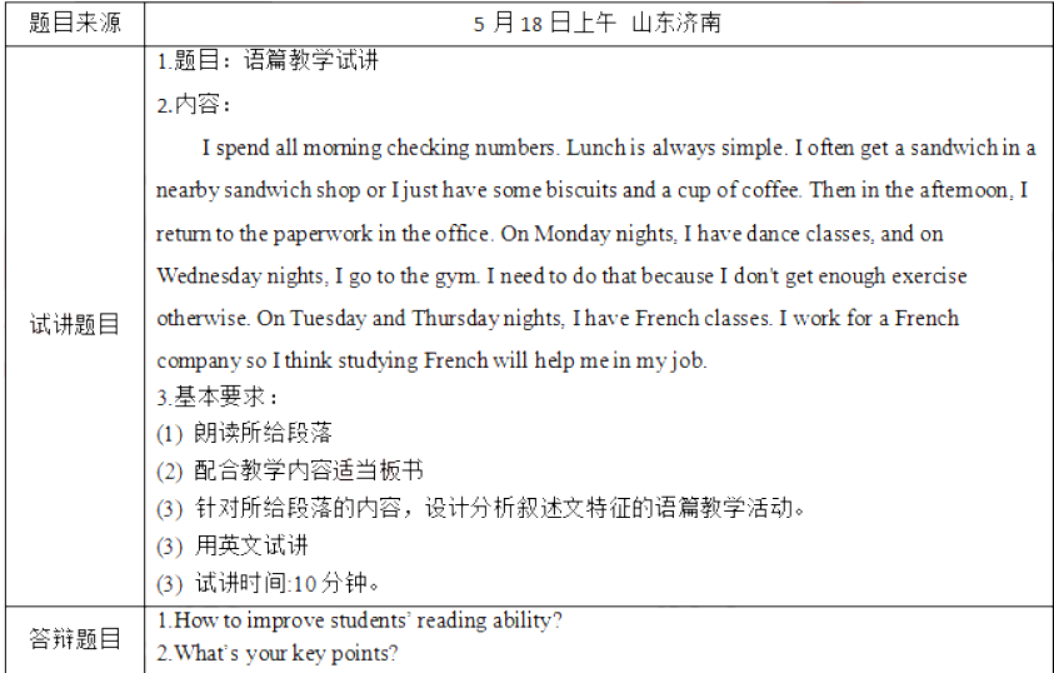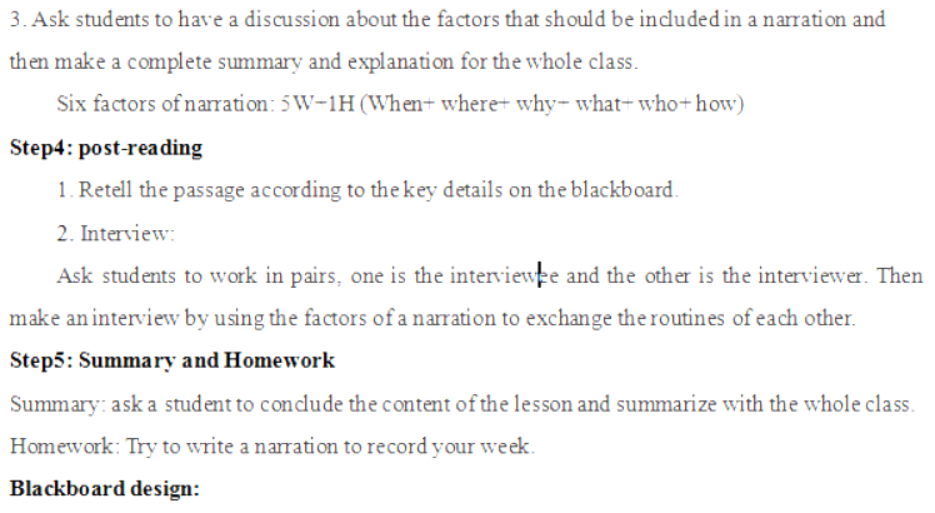高中英语 阅读一、考题回顾
高中英语 阅读
一、考题回顾

一、考题回顾

参考解析
解析:二、考题解析
【教案】
Teaching aims:
Knowledge aims:
(1) Students are able to understand the content of the passage.
(2) Students can know some basic information of narration.
Ability aim:
Students can use different basic reading strategies like analyzing, grasping details correctly in their reading process.
After this lesson, students can write a narration by themselves.
Emotional aim:
Students will be more willing to get involved in class activities and boost their interest in learning English.
Key and difficult point:
Key Point: understand the characteristics of narration.
Difficult Point: improve students’ learning interest and write a narration by themselves.
Teaching procedures:
Step 1: Warming-up
1. Greeting.
2. Have a free talk:
Ask students some questions about their weekend. For example,
1). Did you enjoy your weekend?
2). What did you do on your last weekend? And how about your week days, what did you do?
3.Then ask students to answer the questions and give them some feedback. Then tell them I have friend John he had wrote a short passage to describe his week, and ask my students if they want to know his week or not to lead in the topic of today: “My week”.
Step 2: Pre-reading
1.Prediction.
Ask students to make a prediction about what John does during his week and invite some students to share their ideas.
Write down some of their answers on the blackboard to recall some related words and give evaluation to the students.
Step 3: While-reading
A. Extensive reading
1.Let students to read the passage for the first time. Ask students a question: What does the passage talk about? (This passage talks about the week of the writer)
2.Then invite one student answer the question and give evaluation.
B. Intensive reading
1.Ask students to read the passage for the second time and finish the exercise on the blackboard:
1). John’s lunch is diversified. (T/F)
2). When does John return to the paperwork in the office?
3). What does John do on Monday nights?
4). Where does John go on Wednesday nights?
5). Why does the author study French?
…
2.Then invite two students to answer these questions separately and give evaluation. Write down the right answers on the blackboard.



Reading ability plays a very important role in the process of learning. It is an important part of students’ overall ability. If we want to communicate with others, we should understand what someone is saying. So as a teacher, we should try our best to help students improve their listening ability.
First, before reading, we should lead the students to get familiar with the topic and the potential new words, so that the students can listen to it more smoothly. Besides, we can ask the students to make a prediction about the main idea of the passage to arouse their interest. During reading, we can train students’ reading ability by letting students read for different purposes, for example, getting main idea by extensive reading and getting some detail information by intensive reading. After reading, in order to make students get more familiar with the topic, we can organize some group work, such as, discussion, debate, survey, retelling and so on. After class, we can also give them some reading related homework to have them practise listening.
I hope students can finally improve their reading ability through the above methods.
2. What’s your teaching aims?
【参考答案】
According to the new curriculum standard, I set the following teaching aims:
The first one is knowledge aims: (1) Students are able to understand the content of the passage. (2) Students can know some basic information of narration. The second one is ability aims: Students can use different basic reading strategies like analyzing, grasping details correctly in their reading process. After this lesson, students can write a narration by themselves.The third one is emotional aim: Students will be more willing to get involved in class activities and boost their interest in learning English.
【教案】
Teaching aims:
Knowledge aims:
(1) Students are able to understand the content of the passage.
(2) Students can know some basic information of narration.
Ability aim:
Students can use different basic reading strategies like analyzing, grasping details correctly in their reading process.
After this lesson, students can write a narration by themselves.
Emotional aim:
Students will be more willing to get involved in class activities and boost their interest in learning English.
Key and difficult point:
Key Point: understand the characteristics of narration.
Difficult Point: improve students’ learning interest and write a narration by themselves.
Teaching procedures:
Step 1: Warming-up
1. Greeting.
2. Have a free talk:
Ask students some questions about their weekend. For example,
1). Did you enjoy your weekend?
2). What did you do on your last weekend? And how about your week days, what did you do?
3.Then ask students to answer the questions and give them some feedback. Then tell them I have friend John he had wrote a short passage to describe his week, and ask my students if they want to know his week or not to lead in the topic of today: “My week”.
Step 2: Pre-reading
1.Prediction.
Ask students to make a prediction about what John does during his week and invite some students to share their ideas.
Write down some of their answers on the blackboard to recall some related words and give evaluation to the students.
Step 3: While-reading
A. Extensive reading
1.Let students to read the passage for the first time. Ask students a question: What does the passage talk about? (This passage talks about the week of the writer)
2.Then invite one student answer the question and give evaluation.
B. Intensive reading
1.Ask students to read the passage for the second time and finish the exercise on the blackboard:
1). John’s lunch is diversified. (T/F)
2). When does John return to the paperwork in the office?
3). What does John do on Monday nights?
4). Where does John go on Wednesday nights?
5). Why does the author study French?
…
2.Then invite two students to answer these questions separately and give evaluation. Write down the right answers on the blackboard.



Reading ability plays a very important role in the process of learning. It is an important part of students’ overall ability. If we want to communicate with others, we should understand what someone is saying. So as a teacher, we should try our best to help students improve their listening ability.
First, before reading, we should lead the students to get familiar with the topic and the potential new words, so that the students can listen to it more smoothly. Besides, we can ask the students to make a prediction about the main idea of the passage to arouse their interest. During reading, we can train students’ reading ability by letting students read for different purposes, for example, getting main idea by extensive reading and getting some detail information by intensive reading. After reading, in order to make students get more familiar with the topic, we can organize some group work, such as, discussion, debate, survey, retelling and so on. After class, we can also give them some reading related homework to have them practise listening.
I hope students can finally improve their reading ability through the above methods.
2. What’s your teaching aims?
【参考答案】
According to the new curriculum standard, I set the following teaching aims:
The first one is knowledge aims: (1) Students are able to understand the content of the passage. (2) Students can know some basic information of narration. The second one is ability aims: Students can use different basic reading strategies like analyzing, grasping details correctly in their reading process. After this lesson, students can write a narration by themselves.The third one is emotional aim: Students will be more willing to get involved in class activities and boost their interest in learning English.
相关考题:
设计任务:请阅读下面学生信息和语言素材,设计20分钟英语阅读的教学教案没有固定格式,但须包含下列要点:●teaching objectives●teaching contents●key anddifficult points●majorsteps and time allocation●activities and justifications教学时间:20分钟学生概况:某城镇普通中学高中一年级学生,班级人数40人。多数学生已达到《普通高中英语课程标准(实验)》五级水平。学生课堂参与积极性一般。
单选题2016年我国成年国民数字化阅读四个方式的接触率按从高到低排列正确是:A网络在线阅读>手机阅读>电子阅读器阅读>平板电脑阅读B手机阅读>网络在线阅读>电子阅读器阅读>平板电脑阅读C网络在线阅读>手机阅读>平板电脑阅读>电子阅读器阅读D手机阅读>网络在线阅读>平板电脑阅读>电子阅读器阅读
单选题2016年我国成年国民数字化阅读四个方式的接触率按从高到低排列正确的是:A 网络在线阅读手机阅读电子阅读器阅读平板电脑阅读B 手机阅读网络在线阅读电子阅读器阅读平板电脑阅读C 网络在线阅读手机阅读平板电脑阅读电子阅读器阅读D 手机阅读网络在线阅读平板电脑阅读电子阅读器阅读